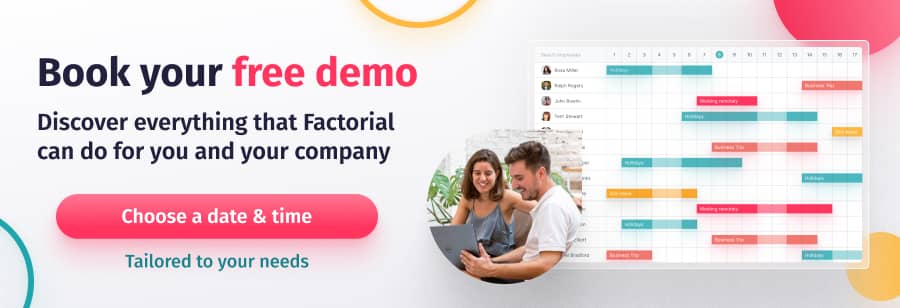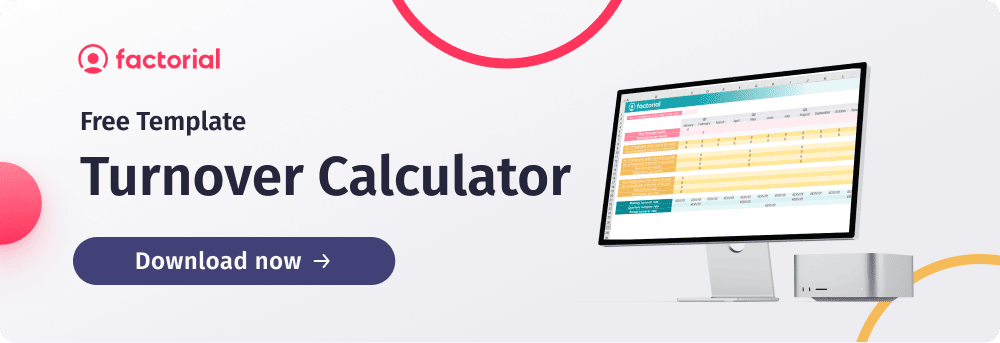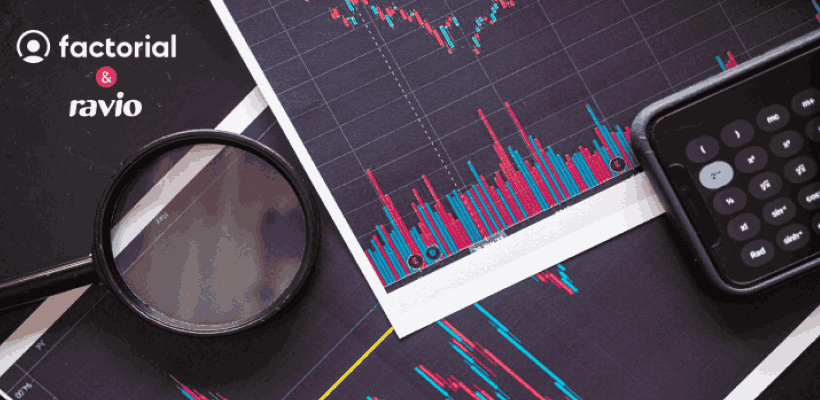Measuring and managing the success of employees is one of HR’s most important roles. However, there’s a lot of data to keep track of, and this can often be overwhelming. You can, of course, use a standard HR dashboard for this. However, you’ll get far more benefits from using a custom dashboard that has been tailored to the specific needs of your business. A comprehensive HRIS with a personalised dashboard can help you keep track of your most important data points. It provides instant access to your essential KPIs so that you can continuously enhance your employee metrics and improve your ROI.
Factorial’s HRIS has included a company dashboard for some time now. This dashboard aggregates data from all your people management processes so you have instant and intuitive access to all the insights you need to grow your business.
But why stop there?
At Factorial, we continuously work to enhance our products so that our customers get the most from our platform. As a result, we are now very excited to announce the launch of our new and improved custom dashboard!
Whether you’re an existing customer or keen to find out what a custom dashboard is and how it can help your business, you’ve come to the right place. Read on to learn everything you need about our exciting new custom dashboard features.
Why Have a Company Dashboard?
An HR dashboard is a digital tool that you can use to centralise and manage all your employee KPIs. HR teams use all this information to make strategic data-driven decisions that help the company grow. This includes enhancing employee performance and development; improving retention and turnover levels; optimising hiring, onboarding and offboarding processes; and upgrading the overall employee experience. You can also use a company dashboard to generate valuable HR reports that enable you to monitor your progress in all these critical areas of your business.
Think of a company dashboard as a control panel that provides you access to your most important employee data points so that you can steer your company to success. The most significant benefit of using one is that all your most essential data is centralised and can be easily accessed by all team members.
There are other benefits, too:
- Increased flexibility.
- Enhanced internal communication.
- Tools for identifying patterns and trends in your business so that you can address issues before they become a problem.
- Streamlined workflows and improved productivity.
- Access to detailed analytics and reporting features.
- The ability to make smarter, data-driven decisions that grow your business and save money.
Above all, when you look for a company dashboard, you need to ensure it is visual and interactive. Data should be easy to read and understand and consist of metrics that relate to the specific needs of your business.
This is where using a custom dashboard can help.
With customisable HR software, you can be sure your team has access to the specific KPIs you need.
Why are Custom Dashboard Features Important?
With a custom dashboard, you get all these benefits and many more. Most importantly, you can tailor the KPIs in your personalised dashboard to align with your business objectives. That way, your dashboard only displays the metrics that are important to you. This makes it much easier to keep track of your progress in all areas of influential people management.
However, before you invest in a custom dashboard, it’s essential to consider which dashboard features you will have access to. The features offered by a solution will determine the level of control over dashboard customisation and the data you can access.
Let’s look at some of the reasons why custom dashboard features are so important in a bit more detail.
Prevent information overload
People management involves keeping track of a lot of data. You need to monitor and manage employee performance; develop employee skills; keep track of time and attendance; manage payroll and leave; and have access to clear and measurable benchmarks to ensure that employees are continuously improving and achieving their goals. You also need to keep track of your diversity metrics; monitor retention levels; ensure your policies are legally compliant; implement onboarding and offboarding processes, and work on measures to improve the overall employee experience. And countless other processes and workflows.
That’s a lot of information.
A custom dashboard can help you streamline all this data and prevent information overload. Instead of using a crowded dashboard with an abundance of data points that might not even be relevant to your needs, you can tailor your personalised dashboard to the information that you need instant access to regularly. That way, you can get quick answers when needed and you won’t get lost in a sea of KPIs every time you log in. Instead, you can select the widget that corresponds to what you need and instantly access all the insights that you are looking for. This helps you make better data-driven decisions without wasting valuable time (or giving yourself a headache).
Ensure that the product you choose includes features for customising the data displayed through your dashboard. This consists of the ability to add, edit, and remove customised widgets so that you can adapt the design of your dashboard in line with your changing needs. That way, you can quickly locate what you need every time you log in.

Make sure visible data is relevant.
It’s also essential to make sure that the custom dashboard you choose includes features to ensure displayed data is visible and relevant.
A visually appealing personalised dashboard must be easy to navigate, and data should be clear and transparent. It should highlight the KPIs that are most important to you so that your team can always find what they need. It should include graphs and other graphics so that you can visualise your progress easily and there is no risk of confusion. And, most importantly, data needs to be relevant and informative. All this will help you understand the bigger picture so you don’t miss any important patterns that might negatively impact your business.
Ultimately, data is only useful if it is well explained and expressed in the proper context. If information is overly complicated or unrelated, then will create clarity and understanding within your team. That’s why it’s so crucial that you pick a product with visually appealing and easy-to-understand data formats. The key to success is keeping your dashboard streamlined and simple. You need everyone on your team to understand exactly what they look at each time they search for data.
Prioritise the right tasks.
Finally, when you search for a custom dashboard, pick a solution with features that enable you to prioritise the tasks that are important to you at any given moment. This will change as your business evolves, so you need a custom dashboard that lets you modify data in line with your changing priorities.
Consider the following when you build your custom dashboard:
- Which areas of your business are you trying to improve?
- Are there any problems that you need to address? (For example, retention levels or the employee experience)
- Which KPIs have the most significant impact on your overall business results?
- What data do you need to track to enhance your business processes?
- What are your top 5 HR metrics right now regarding priorities?
It’s also a good idea to collect regular feedback from your HR team to determine what they want to see on the dashboard or if any displayed data is no longer relevant. Provided you have access to the necessary features, you can adapt your custom dashboard accordingly. Keeping your dashboard continuously updated in line with your priorities can ensure you get the most from your solution now and in the future.
That way, you can:
- Prioritise the right KPIs for your company.
- Generate relevant HR reports at the click of a button.
- Design customised visuals that your team can easily understand.
- Access actionable and relevant insights at a glance.
- Identify trends and patterns that help you determine which areas of your business to prioritise right now.

Factorial’s New Personalised Dashboard Features
With Factorial’s HR software solution, you can create custom dashboards and HR reports in line with the specific needs of your business. Our dashboards leverage all the data collected from each of your HR processes so that you can easily measure and track your KPIs and make strategic decisions based on complex data.
So, what makes our solution so unique?
For one thing, you can create customised dashboards for different processes within your HR department.
You can create a:
- Performance management custom dashboard.
- Training and development custom dashboard.
- Hiring custom dashboard.
- Diversity custom dashboard.
- Leave management custom dashboard.
- Retention custom dashboard.
Moreover, you can tailor your dashboards to display the specific KPIs you want to keep a close eye on. You can also create custom reports straight from your dashboards so that you can share relevant data with your team.
Best of all, we have recently made several improvements to our HRIS to help our customers get the most from our platform. For instance, we have just launched a series of new personalised dashboard features that make your dashboards even more powerful!
Let’s look at some of these new features to see how you can benefit from them.
View/Edit mode
Our new custom dashboard includes two different modes: View Mode and Edit Mode.
You will probably recognise View Mode, as this is what our customers have had access to until now. With this mode, users can interact with all the data displayed through the widgets configured on their dashboard.
Edit Mode is one of our new, updated features. With this feature, admins and managers can customise the look and feel of the dashboard. They can configure which widgets are included and what information is displayed to users. They can also move these widgets around, resize, remove, or add new devices to the dashboard.
All this makes it much easier to design a custom dashboard that meets your business objectives.
Resizing and moving (sorting) widgets
As we just mentioned, with our new custom dashboard features, you can now resize your displayed widgets and move them around. Users can easily drag and rearrange their widgets through Edit Mode according to their preferences. Depending on their needs, they can change their visibility by making them larger or smaller. That way, you can ensure that your prioritised KPIs are the first thing you see when accessing your dashboard.
Removing widgets
Priorities change, and the KPIs that matter most to you one day might be less critical. That’s why we now offer customers the ability to remove widgets once they no longer need to access certain KPIs from their dashboards. And, if your needs change again, you can easily add them back. You can also tag certain widgets as “static” so they remain in place at all times, and there’s no option to remove them.
Adding new widgets
Users can now easily customise their dashboards and add new widgets that are available to them. They can add, delete, or move devices to customise their personalised dashboard layout. This allows them to tailor their homepage to include the data that is most important to them, the data that enables them to succeed in their role.
Restore version
Our custom dashboard now also includes a new feature that enables users to restore the automatically generated version of their dashboard. That way, they can revert to previous settings if needed or reverse any changes that might have been made in error.
Widgets configuration
Finally, users can now configure each widget’s settings displayed on their custom dashboard. Depending on the configuration, each user’s information is also customisable. That way, users can personalise their widgets according to their specific needs.
An HR Solution Tailored to Your Business Needs
A company’s biggest asset is its employees. They form the backbone of your organisation, and how they perform and develop directly impacts your business’s growth. That’s why using the best possible tools and digital solutions to manage your workforce is so important. But it’s not enough to rely on essential, generic tools for this: companies need solutions that specifically work for them.
That’s why the age of the “one size fits all” platform is over.
Companies have specific objectives and requirements and need access to tools that can accommodate their business needs. Otherwise, you will save valuable time and resources on processes that can be easily streamlined and automated with the right product.
Our latest custom dashboard features have been designed with this in mind.
At Factorial, we understand that every company is different. Our customers need a solution tailored to their evolving business needs. We appreciate that these needs change over time, and businesses need access to features that help them adapt their tools whenever required. That’s why we are handing over complete control to our customers.
With our custom dashboards, you can design a tool that works for you and your team. You will easily access all the data you need to improve your people management processes continuously. That way, you will understand exactly what you must do to build a happy, productive, and engaged workforce.




